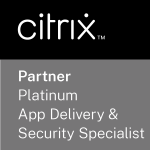Part 4 in cloudDNA’s mini-series considers SD-WAN as alternative to Azure Express Routes or old-school VPNs. Secure, scalable and agile to deploy, Citrix SD-WAN helps to solve everyday challenges like poor user experience or slow backups to or from Azure.
If you have watched the first three parts of this “Get More from Azure” mini-series (find them here), you will have seen how we can introduce products such as Citrix ADC (formerly NetScaler) and Citrix ADM (formerly MAS) into our Azure platform to create a better user experience, improved security and superior visibility, all with the fantastically convenient benefit of centralised management. So, we have created this glorious thing in Azure – but how do we ensure our users can access it? This latest video from cloudDNA CTO and co-founder, Al Taylor, explores how using Citrix SD-WAN instead of your traditional Azure Express Routes and VPNs can improve resilience, reliability, and user experience.
The problem with Express Routes and VPNs
A traditional and common method for providing access to Azure servers is implementing Express Routes – a point-to-point closed circuit between your data centre and your Azure platform, which gives you a reasonably secure, resilient and fast mechanism to work from. However, there are a number of issues with this method. Firstly, it is expensive. Additionally, it operates as a single point of failure, therefore presenting resiliency issues which can put critical services in Azure at risk. Ultimately, it is outdated; it’s rigid and slow to respond to the type of challenges many organisations currently face – and what good is it to increase the traffic into Azure if the network capacity cannot keep up?
There is a smarter way: meet Citrix SD-WAN
Luckily, there is a great way to work smarter and utilise emerging technologies to be able to provide both scale and capability. Citrix SD-WAN takes consumer-grade broadband/internet circuits – or potentially any express routes or VPNs you have already invested in – and bonds them together, providing a greater bandwidth capability by creating an aggregate bandwidth. The really critical benefit it facilitates is resilience; by utilising three links, for example, instead of that single point of failure, SD-WAN can produce an extra level of security or sturdiness. If one link is lost there will still be two operating, taking traffic to and from your Azure platform – so such misfortunes don’t need to be catastrophic.
Branch locations may not be the greatest concern right now – but normalcy will return. Is your infrastructure ready?
With the Citrix SD-WAN solution placed in your Azure platform and in your data centre, you now have the freedom to think a little bit more holistically about what it is you want to achieve. Now, you can start to think about the user experience from all of your locations. Branch locations may not be quite as prevalent right now as in the past, but some semblance of normalcy will return. When it does, you will require access to collaboration services, likely in addition to different types of services users have now become accustomed to with remote working. On top of this, you will need to be able to connect your branch users up to that Azure platform. In SD-WAN you can expand this wide area network out, so branch users can connect directly to your Azure platform in a secure, performant fashion – with the SD-WAN resilience maintaining that connection.
By doing so, you can give users a greater user experience – you can start to ensure that you won’t lose control, you won’t lose security, and you won’t lose visibility. This migration to Azure has potentially started a hybrid multi-cloud journey of which SD-WAN will become a key part.
The platform can be used to give yourselves ultimately the best possible chance of achieving your objectives both today; by being able to get the most out of your Azure investment, and in the future; by being able to extend those functionalities once the world returns to office-based working. Watch the video to discover more!
FIND OUT MORE
If you would like to talk to us about any of the points raised or you have your own challenges that you’d like discuss, please call 0330 010 3443 or email [email protected].





